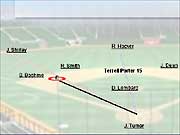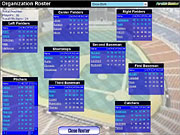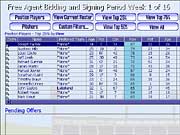Baseball management simulations are usually played with one hand on your mouse and the other scratching your head, trying to decipher the labyrinthine interface. Even the best games of this type require some creative thinking on the part of the player. You almost need to read the mind of developer Tom Tippett to figure out Diamond Mind Baseball 8, and even more user-friendly releases like Baseball Mogul 2003 treat components such as drag-and-drop support as luxuries. If anything has prevented sports management titles from reaching a mainstream audience, it is this user-unfriendliness.

This is not the case with PureSim Baseball. One-man design team Shaun Sullivan has learned from the mistakes of his forebears and created the first baseball management sim that is truly easy to use. Anyone who knows a ball from a bat can sit down with this game and immediately get started on building a contender. This approachable character is combined with a depth of play that is striking for a first effort. Nearly all the nuances of serving as the general manager of a big league ball club are portrayed here, putting to rest the old notion that any sports sim worthy of playing couldn't help but be complicated. Only a sluggish simulation engine prevents it from being a real alternative to the likes of Out of the Park Baseball 4.
However, PureSim Baseball is more of a distant cousin to the Out of the Park games than an immediate family member. Its gameplay is a cross between the gameplay of Out of the Park Baseball and the gameplay of Baseball Mogul, with much of the depth of the former crossed with the latter's focus on the duties of a general manager. You play as the head honcho of a baseball club in an association composed of anything from one league with four teams to the current Major League Baseball setup of 30 teams in two leagues and six divisions. Do well and this will be reflected in your approval rating and continued employment. Turn in some subpar seasons and you can be fired, which forces you to look for new work or start from scratch. The game walks you through the process of creating an association with individual screens that clearly point out what your options are every step of the way. Help options are available everywhere, giving you a full rundown of how things work and why.

In keeping with this theme, the financial aspect of the game has been simplified. The in-game economy is similar to that of Baseball Mogul in that it uses franchise points instead of dollars. Teams can play with either a set number of points per season across the board or with varying values depending on their location. Regions across North America are depicted, ranging from major urban areas like New York-Newark and Los Angeles-Anaheim-Riverside to outer-limits burgs like Winnipeg and Des Moines. The numbers don't vary as much from market to market as they do in the real world, presumably to give people who want to pit the likes of Modesto against behemoths such as Chicago a fighting chance. Even the tiniest town in the game, Corpus Christi, starts with 751,000 franchise points, which is in the same area code as New York, which starts with 1,130,000. It's not difficult to keep even the poorest team at .500 for years and maintain an approval rating high enough to keep you from being fired, although it can be very hard to get beyond being merely competitive and make the playoffs.
Employees and players are signed with franchise points. This is their sole function, as there are no extra financial worries like ticket pricing or TV broadcast rights. Even contracts are based on a sliding scale, with fixed rates regarding the amounts and terms, and a flat fee is assigned to player development each year. But not everything is simple. You do have to hire a scouting director and manager to oversee many day-to-day operational tasks. Scouts are graded A to F according to their ability to rate pitching, hitting, defense, and potential. Good ones are generally capable of building a reasonable roster if you decide to take a pass on some or all of the 60-round opening draft or rely on their advice for each pick. You can even provide guidance in regard to which players they will recommend by tweaking the fiscal persona setting. Establish yourself as a very cheap organization and your scouts will provide cut-rate talent. Set yourself up as a free-spending club and you'll get blue chippers for big bucks.
Managers are pigeonholed according to style and development. Style refers to the manager's preference between hitting or pitching. There are four levels on each side of that preference, so a manager can be strongly in favor of one aspect, only mildly sold on the concept, or simply neutral. Development gauges a manager's ability to work with young talent and veterans along the same sliding scale used for style. You need to choose well, because the man you name as your bench boss will be the only one calling the shots during gameplay. While you can promote players, demote players, and tinker with the batting lineup and pitching rotations, you have no control over games in progress. Thankfully, managers are as intelligent as their counterparts in the scouting department. While they don't make the right calls all the time, they do not make stupid mistakes, and you can adjust manager tendencies. Do some experimentation here and you'll soon find pitchers pulled when you want them to be pulled and pinch hitters inserted at opportune moments.

Players also perform according to expectations. As with the rest of PureSim Baseball, setting things up properly is key. Batters are rated in eight categories governing contact hitting, power, eye, speed, range, arm, hands, and potential. Pitchers are scored in those categories as well, along with additional grades for stuff, velocity, control, endurance, and hold runners. These ratings generally translate into appropriate statistics. Busts and below-par seasons are rarities, which might disappoint those looking for a more rigorous simulation. A hitter with high scores in contact and eye will inevitably do well at the plate, and a starting pitcher with good stuff and control will rack up the wins. Numbers never get to the outrageous levels seen in Major League Baseball in the last few years, thankfully. Home run leaders are usually in the 40s or low 50s, batting-average crowns are won with totals in the mid-.300s, and the best pitchers top out at just over 20 wins. Hit totals and saves seem slightly elevated, but not unreasonably so.
All these numbers are presented in attractive menu screens that are easy to understand and use. The main page for each team lists all the pertinent information. Your current scouting director, manager, and approval rating are noted, along with all franchise point expenditures and both the current team record and that of all past seasons. More detailed numbers are available by clicking on the links on the left of the screen. There you can readily access your lineup, pitching rotation, and other items of interest to your team, along with league-wide standings, statistics, and other pertinent information. Every item you click on leads to a page with the data that you were seeking laid out in a simple, intuitive manner. These screens make good use of color, allowing you to sort lines of text at a glance and not become too bogged down in number crunching. There is even a regularly updated newsletter called PSPN.com that offers tidbits like power polls and informal ratings of the most feared hitters in the league. Also, games can be watched on a screen that features a graphical representation of a ball diamond and lines depicting each stroke of the bat.

Unfortunately, all of the above comes with a catch. Although PureSim Baseball is one of the more enjoyable baseball management sims available, its glacierlike speed won't win it any friends. Associations with more than 20 teams slow the simulation time to a crawl. Play with a two-league, 24-team association required upward of four minutes to simulate a week's worth of games, nearly 15 minutes to simulate a month, and around 90 minutes to simulate a season. And that's with an Athlon XP 1700+ with 512MB of memory, considerably more than the PIII 800, 128MB system listed as the requirement for a large association. Those times are trimmed considerably when using fewer teams, though events proceed slowly even when you're not simulating games, as computer-controlled teams continually pause to think about personnel moves. At any rate, it is a challenge to get through even a single season in one evening, something that is sure to annoy players used to the speedier pace of games like Out of the Park Baseball 4 and Baseball Mogul 2003.
Still, there's too much to like here to let one problem, however glaring, be a deterrent to enjoying PureSim Baseball. A full-featured 10-day trial version is available for download at the official Web site, which is also the only place to buy the game. Baseball fans with some time to spare--and a modicum of patience--shouldn't let this one pass them by.